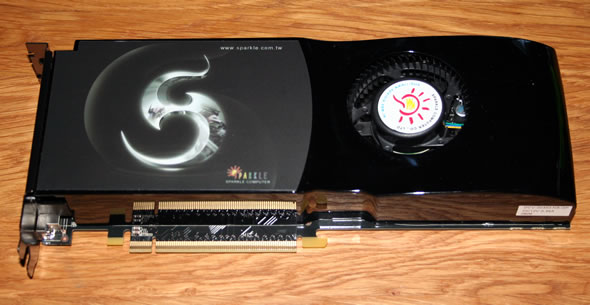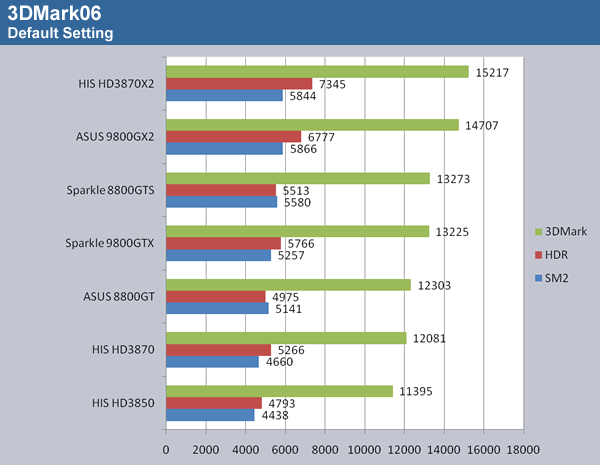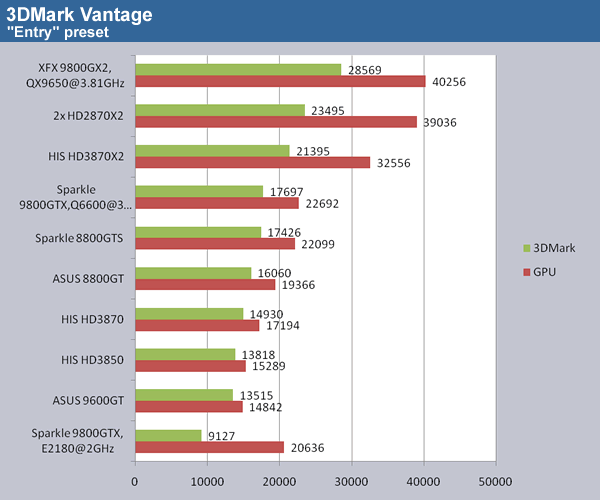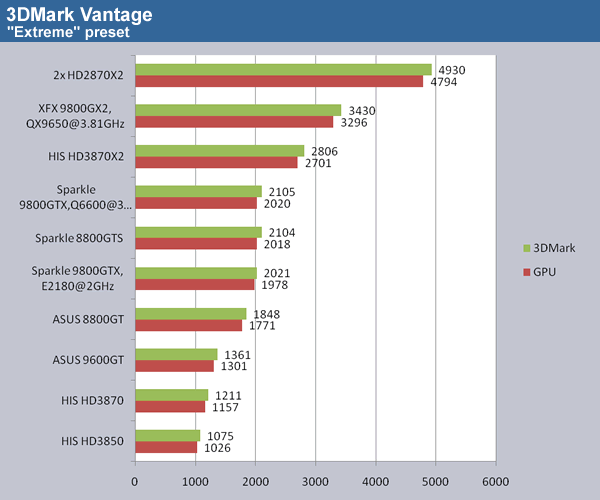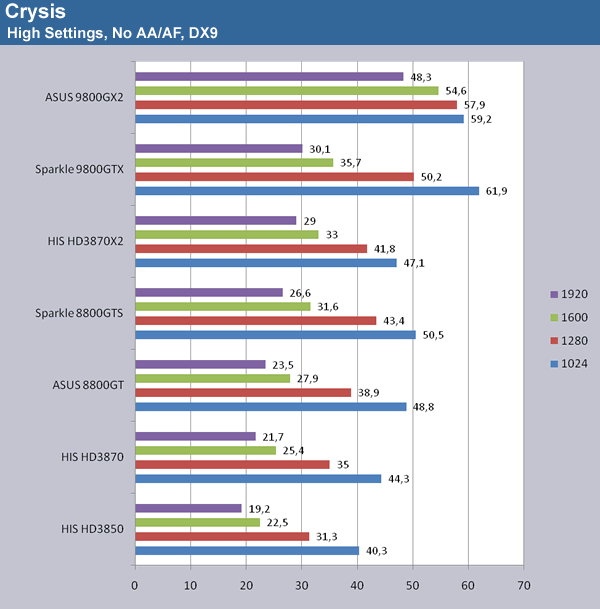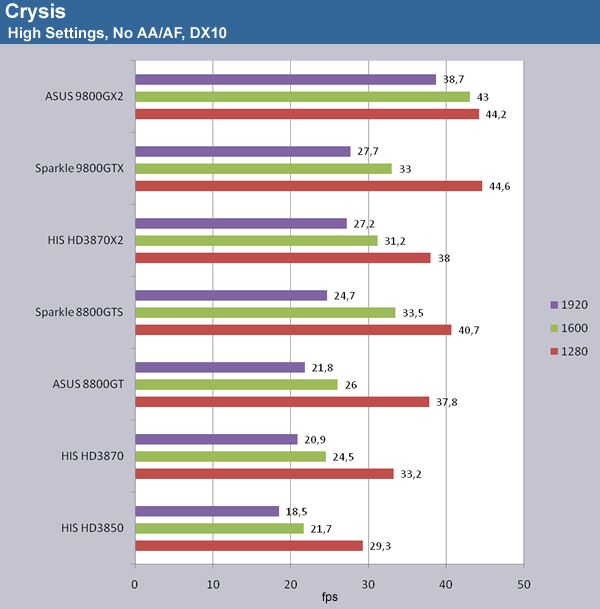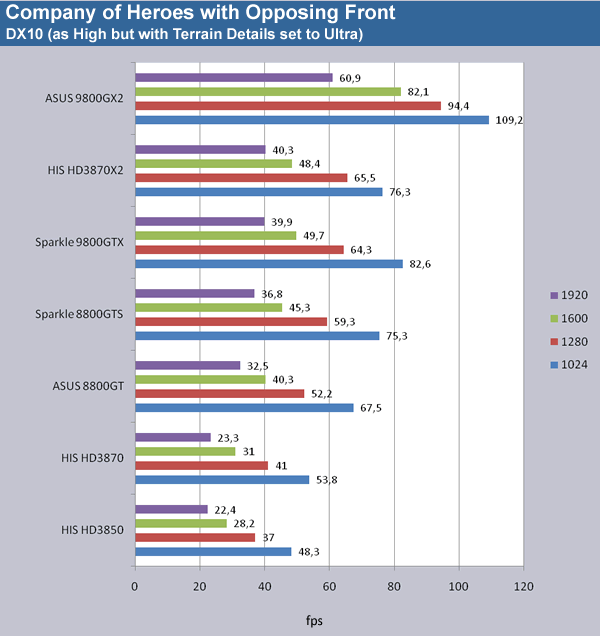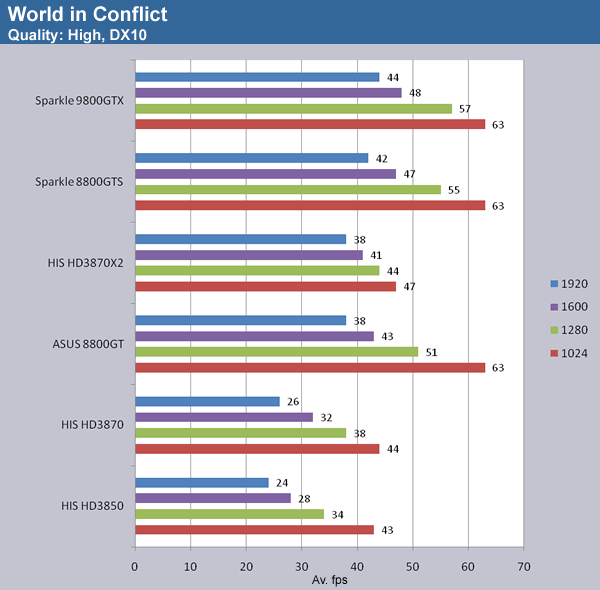Despite its name the GeForce 9800GTX is mostly a higher clocked GeForce 8800GTS 512 MB. That does not matter though as well know how good that GPU was/is. We have tested the Sparkle 9800GTX to see if it can match the quality of the Sparkle 8800GTS 512 MB.
INTRODUCTION
With the GeForce 9-series NVIDIA has created quite a lot of confusion. Instead of a major update it seems that most GeForce 9 cards are merely updated versions of GeForce 8 cards, and unfortunately named so you cannot figure out which card is based on which.
The GeForce 9800GTX is a perfect example. While the name implies that it is an upgrade for the GeForce 8800GTX, which it in a way is, it also is just a higher clocked GeForce 8800GTS 512 MB. You might wonder why NVIDIA didn’t just use GeForce 9 for all their G92 based cards but we may never know why.
If you read our review of the Sparkle 8800GTS 512 MB you know that we really liked the card. So it sounds logical that the Sparkle 9800GTX should be just as good, doesn’t it? Well, that is what we want to find out in today’s review as we test it in a variety of benchmarks.
ABOUT SPARKLE
Sparkle is a company from Taiwan that makes and sells video cards that use NVIDIA’s various GPU’s on them. They were established in 1981. They mainly sell their cards in Europe and Asia but CompUsa and Tiger Direct have now started carry a few of their cards so hopefully their presence in the USA will grow. You can read about the company here.
FEATURES AND SPECIFICATIONS
As this chart shows the GeForce 9800GTX is mainly a higher clocked GeForce 8800GTS.
| Sparkle 8800GTS 512 MB | |||
| Specification | ASUS 8800GT | Sparkle 9800GTX | Sparkle 8800GTS 512MB |
| RAMDACs | Dual 400 MHz | Dual 400 MHz | Dual 400 MHz |
| Memory BUS | 256 bit | 256 bit | 256 bit |
| Memory | 512 MB GDDR3 | 512 MB GDDR3 | 512 MB GDDR3 |
| Memory Clock | 1800MHz | 2200 MHz | 1940 MHz |
| Stream Processors | 112 | 128 | 128 |
| Clock Rate | 600 MHz | 675 MHz | 650 MHz |
| Chipset | G92 | G92 | G92 |
| Bus Type | PCI-E 2.0 | PCI-E 2.0 | PCI-E 2.0 |
| Fabrication Process | 65nm | 65nm | 65nm |
It also shares the same features as the GeForce 8800GTS 512 MB with the added feature of supporting Tri-SLI on the new NVIDIA motherboards.
NVIDIA® unified architecture
Fully unified shader core dynamically allocates processing power to geometry, vertex, physics, or pixel shading operations, delivering up to 2x the gaming performance of prior generation GPUs
Full Microsoft® DirectX® 10 support
DirectX 10 GPU with full Shader Model 4.0 support delivers unparalleled levels of graphics realism and film-quality effects
NVIDIA® SLI™ technology
Delivers up to 2x the performance of a single GPU configuration for unparalleled gaming experiences by allowing two graphics cards to run in parallel. The must-have feature for performance PCI Express® graphics, SLI technology dramatically scales performance on today’s hottest games.
PCI Express 2.0 support
Designed to run perfectly with the new PCI Express 2.0 bus architecture, offering a future-proofing bridge to tomorrow’s most bandwidth-hungry games and 3D applications by maximizing the 5 GT/s PCI Express 2.0 bandwidth (twice that of first generation PCI Express).PCI Express 2.0 products are fully backwards compatible with existing PCI Express motherboards for the broadest support.
GigaThread™ Technology
Massively multi-threaded architecture supports thousands of independent, simultaneous threads, providing extreme processing efficiency in advanced, next generation shader programs
NVIDIA® Lumenex™ Engine
Delivers stunning image quality and floating point accuracy at ultra-fast frame rates:
16x Anti-aliasing: Lightning fast, high-quality anti-aliasing at up to 16x sample rates obliterates jagged edges
128-bit floating point High Dynamic-Range(HDR):Twice the precision of prior generations for incredibly realistic lighting effects-now with support for anti-aliasing
NVIDIA® Quantum Effects™ Technology
Advanced shader processors architected for physics computation enable a new level of physics to be simulated and rendered on the GPU –all white freeing the CPU to run game engine and AI
NVIDIA® ForceWare® Unified Driver Architecture (UDA)
Delivers a proven record of compatibility reliability and stability with the widest range of games and applications
ForceWare provides the best out-of-box experience and delivers continuous performance and feature updates over the life of NVIDIA GeForce® GPUs
OpenGL® 2.0 optimizations and support
Ensures top-notch compatibility and performance for OpenGL applications
Dual 400MHz RAMDACs
Blazing-fast RAMDACs support dual QXGA displays with ultra-high, ergonomic refresh rates –up to 2048×1536@85Hz.
Dual Dual-Link DVI Support
Able to drive industry’s largest and highest resolution flat-panel displays up to 2560×1600 and with support for High-bandwidth Digital Content Protection(HDCP).
NVIDIA PureVideo HD technology
The combination of high-definition video decode acceleration and post-processing that delivers unprecedented picture clarity, smooth video, accurate color, and precise image scaling for movies and video.
Discrete, Programmable Video Processor
NVIDIA PureVideo is a discrete programmable processing core in NVIDIA GPUs that provides superb picture quality and ultra-smooth movies with 100% offload of H.264 video decoding from the CPU and significantly reduced power consumption.
Hardware Decode Acceleration
Provides ultra-smooth playback of H.264, VC-1, WMV and PEG-2 HD and SD movies.
HDCP Capable
Designed to meet the output protection management (HDCP) and security specifications of the Blu-ray Disc and HD DVD formats, allowing the playback of encrypted movie content on PCs when connected to HDCP-compliant displays.
Advanced Spatial-Temporal De-Interlacing
Sharpens HD and standard definition interlaced content on progressive displays, delivering a crisp, clear picture that rivals high-end home-theater systems.
High-Quality Scaling
Enlarges lower resolution movies and videos to HDTV resolutions, up to 1080i, while maintaining a clear, clean image. Also provides downscaling of videos, including high-definition, while preserving image detail.
Inverse Telecine (3:2 & 2:2 Pulldown Correction)
Recovers original film images from films-converted-to-video (DVDs, 1080i HD content), providing more accurate movie playback and superior picture quality.
Bad Edit Correction
When videos are edited after they have been converted from 24 to 25 or 30 frames, the edits can disrupt the normal 3:2 or 2:2 pulldown cadence. PureVideo uses advanced processing techniques to detect poor edits, recover the original content, and display perfect picture detail frame after frame for smooth, natural looking video.
Noise Reduction
Improves movie image quality by removing unwanted artifacts.
Edge Enhancement
Sharpens movie images by providing higher contrast around lines and object
Integrated SD and HD TV Output
Provides world-class TV-out functionality via Composite, S-Video, Component, DVI, or HDMI connections. Supports resolutions up to 1080p depending on connection type and TV capability.
CLOSER LOOK
There isn’t much that distinguishes this card from the GeForce 8800GTS 512 MB from Sparkle.
The card comes in the now familiar Sparkle-box. It is a nice looking box but the more cards that Sparkle release which uses this box the harder it is to distinguish the cards from each other when on the store shelf.
Inside the box we find the same meager bundle as we got with the Sparkle 8800GTS 512 MB.
- The card
- Component-out cable
- DVI=>VGA adapter
- Manual and CD
Again Sparkle has chosen not to include a HDMI-adapter with the card. It is a decision I cannot really understand.
The card itself looks almost the same as the Sparkle 8800GTS 512 MB but a closer look reveals it to be a bit longer.
It also has two 6-pin PCI-E power connectors while the Sparkle 8800GTS 512 MB only needed one. I’m guessing they were close to the limit what the PCI-E slot can provide and needed a bit more power for the 9800GTX.
HOW WE TESTED THE CARD
The Sparkle 8800GTS 512 MB was tested together with a group of other video cards on the following system.
- Intel Q6600 @ 3 GHz
- 2 GB DDR2 @ 800 MHz
- ASUS Maximum Formula X38 motherboard with PCI Express 2.0
The following video cards were tested:
- HIS HD 3870 IceQ 3 Turbo
- HIS HD 3870 X2
- HIS HD 3850 IceQ 3 Turbo
- Sparkle 8800GTS 512 MB
- ASUS 8800GT
- Sparkle 9800GTX
The drivers used in this review were Catalyst 8.3 for the AMD cards, ForceWare 174.53 for the 9800GTX and ForceWare 169.44 for the rest of the NVIDIA cards.
For this review we used the following games to test the performance:
3DMark06 – Technically not a game but we all know why we are using it. It is starting to get old now so the results are of limited interest. It was tested at default and 1920×1200/4xAA/16xAF.
3DMark Vantage – This is the latest version of the popular 3Dmark-benchmark released in April 2008.
Crysis – One of the most demanding games released. We used a Crysis Benchmark utility and used the demo included with the game that stresses the GPU. The game was benchmarked with the High setting, no AA/AF and both DX9 and DX10.
World In Conflict – While short, this was one of the best RTS-games of 2007. We used the built-in benchmark and tested the game with the High setting, both with DX9 and DX10.
Company of Heroes – Another great RTS game which also has DX10 support. The latest patch was installed and everything was set to the highest setting. When DX10 rendering was chosen the Terrain Detail was set to Ultra instead of High.
Last but not least we recorded the power consumption both after the cards had sat at the Windows Desktop for a few hours and during a couple of loops of 3DMark06 at 1920×1200/8xAA/16xAF. The maximum Wattage was recorded.
3DMARK06
Even though the Sparkle 9800GTX is clocked higher than the Sparkle 8800GTS 512 MB it still performs almost the same in this benchmark. The 9800GTX scores a bit higher in the HDR-test while performing worse in the SM2-test.
We expected the Sparkle 9800GTX to draw ahead of the 8800GTS 512 MB when we turned the settings up but they still are running neck-to-neck.
3DMARK VANTAGE
As 3DMark06 is starting to get quite old and no longer is able to give a good approximation of the performance of modern video cards we have waited long for the successor and here it is. 3DMark Vantage is Futuremarks latest version of this popular benchmark and built to stress the current video cards to the limit. We’ve posted an article about the benchmark which explains how it works.
The Crossfire-systems (2xHD3870X2 and HD3870X2)
had issues with corrupted textures in the first Graphics test
With the “Entry” preset it is quite obvious how important the CPU is for the final score. When run on a E2180 Dual Core CPU @ 2GHz the 9800GTX gets a final score of only slightly more than half compared to when it is running on a Q6600 @ 3 GHz. The 9800GTX narrowly beats the 8800GTS 512 MB.
The Crossfire-systems (2xHD3870X2 and HD3870X2) had issues with corrupted textures in the
first Graphics test and thus the results should be taken with a pinch of salt.
The “Performance” preset still is affected by the CPU speed. The 9800GTX is slowly starting to draw ahead of the 8800GTS 512 MB.
The Crossfire-systems (2xHD3870X2 and HD3870X2) had issues with corrupted textures in the
first Graphics test and thus the results should be taken with a pinch of salt.
At the “High” preset the CPU is basically unimportant. Instead the GPU is being pushed hard. if we look at the actual framerates for each graphics test we see that most cards score around 5-15 fps. There’s a lot of room to improve. Again the 9800GTX is beating the 8800GTS 512 MB although the margin is very slim.
The Crossfire-systems (2xHD3870X2 and HD3870X2) had issues with corrupted textures in the
first Graphics test and thus the results should be taken with a pinch of salt.
Last but not least the “Extreme” preset really pushes the cards to their limit. It probably will take a few years before we see cards hitting 15000 or more here. The CPU is basically unimportant in this test. Here we notice that the 9800GTX is performing equally to the 8800GTS 512 MB. This is quite surprising as you would expect that the extra clockspeed would have the most impact at this setting where the GPU is pushed to its limit.
CRYSIS
In our first tested game we see a completely different result than in the synthetic 3DMark-benchmarks. The Sparkle 9800GTX performs much better than the 8800GTS 512 MB.
As we select DX10 the picture stays the same. The difference is not huge but in Crysis every fps counts.
COMPANY OF HEROES
Just like in Crysis the Sparkle 9800GTX manages to pull ahead of the 8800GTS 512 MB. Generally you get around 8-9% higher fps than with the 8800GTS 512 MB.
WORLD IN CONFLICT
In World in Conflict the Sparkle 9800GTX does not manage to perform much better than the 8800GTS 512 MB.
POWER CONSUMPTION
The power consumption is measured at the wall and relates to the whole system:
Q6600@3GHz, 2GB DDR2, Blu-Ray SATA disk, 3x SATA HD
Remember that the 9800GTX has two PCI-E power connectors while the 8800GTS 512 MB only has one. When running at the default clocks they both draw almost exactly the same amount of power suggesting that you could run the 9800GTX with just one cable. The second cable most probably is most usefull if you want to overclock the card a lot.
CONCLUSION
We were very impressed with the GeForce 8800GTS 512 MB from Sparkle in our review a while ago. As this in many ways is the same card we of course also are very impressed with this card. The performance you get at this price level is pretty impressive. There is nothing that makes this card stand out from the competition except for the price. Compared to other 9800GTX the Sparkle 9800GTX is one of the cheapest ones. On the other hand you do not get any DVI=>HDMI adapter and there is not even the option to hook up sound to the card. The bundle is also non-existent.
The question of course is what benefit this card actually has over a regular 8800GTS 512 MB. In our benchmarks we see both games where the extra clock speed is put to good use and games where you do not get any increase in performance at all. Bottom line is that if you can find the Sparkle 9800GTX at the same price as the Sparkle 8800GTS 512 MB you definitely might as well go with the 9800GTX. There is however little sense in paying a premium for the 9800GTX over the 8800GTX 512 MB unless Tri-SLI support is really valuable for you.
Pro
+ Excellent performance for a low price
+ Quiet
+ Tri-SLI support
Con
– No HDMI-adapter
– No way to get audio through the DVI-connector even with an adapter
– Little performance gain over a 8800GTS 512 MB
The Sparkle 9800GTX get an 8 out of 10 and a Bjorn3D Seal of Approval award.
 Bjorn3D.com Bjorn3d.com – Satisfying Your Daily Tech Cravings Since 1996
Bjorn3D.com Bjorn3d.com – Satisfying Your Daily Tech Cravings Since 1996



